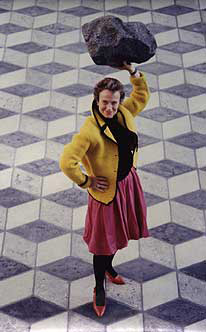
After she was diagnosed with breast cancer, Topher Delaney, a San Francisco–based artist and landscape designer, made a pact with God. If she survived, she swore she would devote her work to helping others heal. Now, almost a dozen years later, Delaney has created a specialty in the design of healing gardens for hospitals and sanctuaries for residential and business clients. A new book, Ten Landscapes (Rockport, 2001), displays some of Delaney’s residential projects, which, like her institutional work, is as colorful, upbeat, and unorthodox as the artist herself.
What is your work about?
Everything I do, whether for a hospital, a business, or a residence, is about comfort, healing, and faith. When I was beginning my career, landscape design appealed to me as a form of sculpture and as a way of showing my commitment to the environment. It seemed to be the perfect combination of art and civic responsibility. What I have realized along the way is the tremendous power gardens can have on people’s psyches. My work, it seems, is always a series of programmatic responses to complex emotional issues.
For example?
I designed a roof garden for the Bank of America building in San Francisco. The company was struggling with personnel issues because they have many employees who work more than one job and are always exhausted as a result. They have many computer programmers who never see the light of day. So we made an active environment using recycled materials, with generous benches where people sleep during their breaks. It is like a private sanctuary for every employee.
Sanctuary does seem like a better word than garden or landscape for what you create.
The word garden, from the German garten, originally meant enclosure. So if you think about this in a metaphysical way, a garden should be more than just a pretty object. It should be like an embrace.
The issues of people suffering from cancer are something you can relate to all too well, it seems.
Being in a hospital is a terrifying process because you lose control over your own body. When you have a cancer, it is a long-term proposition. For months, sometimes years, there are significant, invasive courses of treatment. I created a garden at the Marin Cancer Institute where I used the source plants for the different pharmaceuticals employed to treat cancer. For instance, the plant catharanthus roseus is used to make Vinblastine Sulfate and Podophyllin is made from phodophyllum peltaltum. We created a booklet with a descriptive narrative that people can use to educate themselves while enjoying the spaces. In the act of learning about their treatment, people regain some sense of control over their destinies.
What are you working on now?
I just returned from New York. I’ve designed a memorial for those who died on September 11; not for the site of the World Trade Center, specifically, but for all of Lower Manhattan below Canal Street. The idea is to present the family members with an index of species of trees that currently thrive in Manhattan and to let them choose the kind of tree they’d like to memorialize their loved one. Each tree would have a plaque with the name of the person who perished and his or her age and hometown, or some other text. This would celebrate the memory of those killed, and also be a gift of hope to the city. A tree is a wonderful symbol of the future.
